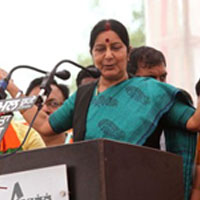Opinion Looking east,building bridges
Let us look to our maritime border with Southeast Asia,and jointly help the Northeast and Myanmar develop
We are on the eve of observing the 20th anniversary of a reorientation in our foreign policy focus. If a precise date has to be set for its formalisation,we will obviously have to begin with the India-ASEAN sectoral dialogue partnership in 1991. In 1994,Prime Minister Narasimha Rao,during his visit to Singapore,outlined a significant reorientation of Indias foreign policy when he spoke about Look East. Since then the broad contours of a Look East policy have fallen in place,and gradually crystallised: full dialogue partnership and joining the ASEAN regional forum in 1996; the start of annual ASEAN-India summit meetings in 2002; the conclusion in 2004 of a partnership for peace,progress and shared prosperity are only some of the milestones. Others can also be identified and named. This policy has had all the characteristics of bipartisanship which is one of the strengths of Indian democracy and the Indian political system when it addresses central issues of national importance…
Over the next decade our Look East policy,and further changes in the Indian economy,will take place in an environment which would be in considerable,if not complete,contrast to a unipolar universe. A key imperative of Indian foreign policy has been to secure an environment in which we can face up to the central challenges of nation-building. This includes addressing the persistence of mass poverty in India,substantially upgrading our administrative delivery systems and infrastructure not just to sustain a high rate of economic growth,but also to improve substantially access to education and health services. A continued integration with the world economy is also essential for us to achieve as much as possible in the attainment of these national development goals in as short a time span as possible…
A Look East policy,or an integrated Southeast and East Asia policy,necessarily requires a maritime perspective of and from India. In cartographic terms,we need to look at ourselves not as if we are only looking down from the Himalayas to the Indian Ocean,but rather down from the peninsula towards the Himalayas. Such a cartographic inversion is by no means easy. We cannot disregard our continental compulsions,whether to the northwest,the north,or the northeast. Nevertheless,we have to balance these compulsions with a maritime perspective in which our southern peninsula equally becomes the heart and mind of our foreign policy. I would like to imagine that this maritime perspective is now embedded in our foreign policy thinking. I will however readily grant the point to a sceptic that it needs to be even more deeply embedded.
A maritime perspective necessarily means sea power but I do not imply by this just the need for a strong navy. It is rather a web of economic,commercial and political ties with the countries in Southeast Asia and North Asia,as well as the wider Pacific community,that we have to reach out to. This perspective,in fact,means also returning to our roots in ancient maritime history the Mauryas,the Chalukyas,the Cholas and other kingdoms and dynasties who were flourishing maritime entities… It is my view and conviction that in the next decade or two we will see a full flowering of this maritime perspective in India with its attendant scholarship and also retrieving from the annals of history our ancient and historical links with the countries of Southeast Asia and beyond.
It has become a truism almost to speak about the shift of power to Asia. I doubt that anyone would seriously question the fact of this seismic shift or that its main driver has been the rapid economic growth in China,and in the tiger economies of Southeast Asia and now for the past decade rapid growth in the Indian economy. I would however like to dwell on what is happening within Asia even as this overall shift of economic,political and financial power takes place from the west to the east. Evidently there is a reconfiguration within Asia also underway and we have to see and juxtapose south,southeast,north and north-east Asia…
In the case of the India-China interface the problem is more complex,since that interface comprises both a very direct maritime,and also continental,dimension. Notwithstanding our benign engagement over the centuries,the second half of the 20th century casts a very long shadow. However,what one also discerns are positive possibilities that emerge from the maritime interface in its widest possible sense economic,political,cultural and religious,between India and China,as these offer grounds for deepening and strengthening our bilateral relations. This process will reduce the relative weightage of the considerable intractability of our continental interface. The fact that we are together in important groupings such as the East Asia Summit or the ADMM+ mechanisms is itself a very important positive development. In this perspective a continued expansion of the China-India economic relationship,and expansion in cultural,scholarly and people to people ties,along with a candid political relationship are necessary,for difficulties can reasonably be expected from time to time…
Myanmar and the northeastern states of India are together the bridge between South and Southeast Asia. That bridge needs special focus and concerted attention. It is a vital strategic lynchpin which can transform our economies. India and ASEAN together have the means and the capacities to face up to this challenge. We must find the political will to do so…
Swaraj is the leader of the opposition in the Lok Sabha,Extracted from a public lecture on September 14 at the Institute of South Asian Studies,Singapore





